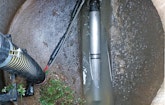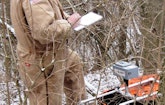Interested in Location/Detection?
Get Location/Detection articles, news and videos right in your inbox! Sign up now.
Location/Detection + Get AlertsMagnetic-RFID identifies underground assets quickly
Problem
Underground utility asset location and identification is a very costly problem for utilities and municipalities. Problems range from digging accidents to time-consuming costs locating underground asset points before repairs or construction can even begin. The Village of Thiensville, Wis., had just such a challenge.
Solution
Thiensville worked with Ruekert-Mielke and Berntsen International to locate and accurately mark their ductile iron force main. The three-step process included vacuum extraction to verify the exact sewer location, survey grade GPS location data entered in a web-based GIS application and installation of InfraMarker Magnetic-RFID markers at the asset locations.
Result
All critical asset points were successfully identified and subsequently found in less than 10 minutes. 877/686-8550; www.inframarker.com.
Rapid inspection device uses acoustics
Problem
A major federal facility in Missouri wanted to develop a picture of flow conditions in its wastewater collection system.
Solution
CH2M HILL’s Lawrence, Kan., office chose the Sewer Line Rapid Assessment Tool from InfoSense to identify blockages and conduct a broad flow condition survey to prioritize cleaning. The transmitter, placed in an open manhole, transmits tones. In a downstream manhole, the receiver compares the tones with sounds it should hear in a clean pipe. If the signal is degraded, algorithms analyze it and present the operator with a simple assessment in real time on a scale of zero to 10. The acoustic inspection takes less than three minutes without contacting the waste stream.
Result
Two technicians working independently inspected 400 segments totaling more than 70,000 feet in 11 days. They found several blockages, but overall the system needed little cleaning. Had the facility chosen to purchase the inspection device, the labor saved by not cleaning 100 percent of the system would have paid for it. The technology won the 2012 Water Environment Federation Innovative Technology Award. 877/747-3245; www.infosenseinc.com.
Noninvasive leak detection reduces water loss
Problem
The Greensboro (N.C.) Water Resources Department used electronic listeners to locate leaks throughout a 1,500-mile service area. The technology had limited accuracy, especially when locating leaks under roadways and concrete structures. Officials searched for a more reliable solution that would not disrupt service or require excavation.
Solution
The city adopted LeakFinder, a Windows-based acoustic leak detection system from Echologics. An enhanced correlation function enables it to accurately identify and locate narrow-band leak noise on pipes of all diameters and materials.
Result
“We quickly pinpointed more than 50 leaks of various sizes in high-traffic areas without the enormous cost of excavating different locations to find them,” says utility coordinator David Carpenter. 866/324-6564; www.echologics.com.
Scanning systems help utility discover infiltration source
Problem
Two subbasins within the James City Service Authority (JCSA) experienced a serious and persistent infiltration problem, despite the PVC pipe being only 20-30 years old. Located between the James River and an inland lake in Williamsburg, Va., the 10-year, 24-hour peak-hour flows for these basins were five to seven times greater than thresholds. In spite of an EPA-mandated CCTV inspection, smoke testing and open-channel monitoring program, JCSA was unable to identify sources of infiltration.
Solution
Facing an estimated $2.8 million rehabilitation bill to bring both basins into compliance with their consent decree, officials decided to use Electro Scan to identify and quantify potential infiltration within their sewer mains and laterals. They contracted with Prism Contractors & Engineers of Yorktown, Va., to scan both subbasins. The contractor proposed using the ES-620 system to assess its sewer mains and the ES-38 for its laterals, to quickly evaluate the area, with no disruption to residents or the sanitary sewer system.
Result
Both subbasins (combined 20,000 lf) were scanned in only five days, following the F2550-06 ASTM Standard. The data was immediately processed and loaded in the field onto a cloud-based viewing platform, www.criticalsewers.com, where the JCSA staff was able to instantly review it. Initial analysis showed defects in the sewer mains, not the laterals. 916/779-0660; www.electroscan.com.









